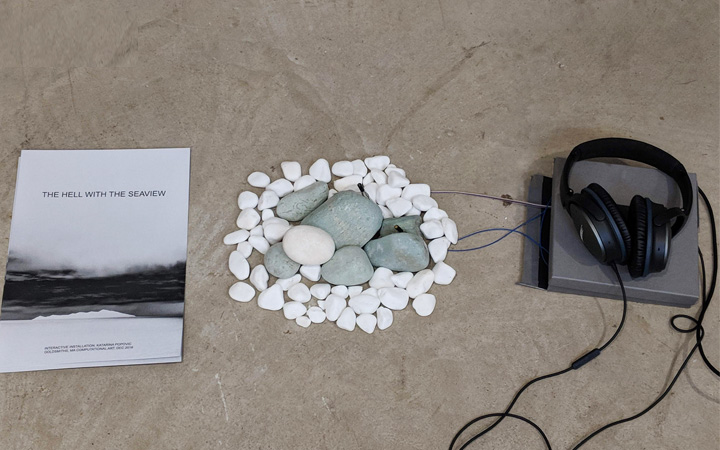The Hell With the Seaview
This is an interactive installation dedicated to the survivors of the Goli otok political prison from Yugoslavia. The meaningless process of stone chiseling and the torture that these men and women sustained was the starting idea for turning silent objects into witnesses.
If rocks could talk, they would have told us (or maybe even screamed) their stories. Now they can.
produced by: Katarina Popovic
The immersive history approach
Instead of presenting what has happened through books, papers or video – although they are powerful communication tools, the use of technology can give us an imminent experience of what was going on there. The headphones were used to make the experience more intimate, and bring the visitor closer to the story. Through the actual experience of kneeling in front of the rocks and the sea and with the specific sounds echoing in the space (rocks hitting) as well as listening to the content in a specific audio environment, I was able to convey a powerful, touching story.
The Barren Island - Goli otok
The Barren island (Goli otok) was a dreadful political prison during the times of Yugoslavia. With sparse vegetation and its rocky structure, it was a very tough place. There, the political prisoners were taken for a re-education.
The inmates would endlessly chisel in stone, or carry the heavy, rocky loads, over 12 hours a day, in scorching heat or cold or rain, while being regularly tortured. All of this was a part of their "re-education" although their various 'political' misconducts were often just saying a wrong joke or being in the wrong place at the wrong time. Any misconduct or complaint was treated the same – with beating and torture. Ironically, this prison was on an island in the beautiful Adriatic Sea. The people who were there gave it a nickname – The Living Hell.
The immersive experience is physical, visual and auditory
Once the visitor enters the installation, he/she kneels in front of the rocks, puts the headphones on and hits one of the rocks with the other rock. The biggest rock ‘holds’ a poem. The second biggest one – the story.
And all the while one is listening to the horrors, there is a beautiful sea view in front giving a stark contrast. If the experience creates unrest or an unpleasant feeling, that is exactly right because that is a part of the empathetic experience - you get to 'feel' a part of that pain and terror. This is how one understands on a deeper level and is changed from the inside. I myself had a very hard time reading the poem by one of the prisoners, as it was bringing tears to my eyes every time during the recording.
The poem was deliberately told in Serbian since the words are very scarce and their power was lost when I tried the English translation. Therefore, the translation was printed in the catalog accompanying the installation.
The physical computing behind it
The Adafruit Audio FX Sound Board - WAV/OGG Trigger with 16MB Flash is a wonderfully simple and practical piece that lets you integrate sound into your project, but sometimes things are not as simple as they seem.
The first attempt to make the soundboard work with Arduino was attempted with the Adafruit Sound Library using the Software serial.
Once I have soldered some 24 miniature holes on the soundboard (and got new skills!), connected everything, the serial monitor showed that there was a soundboard there, but nothing else. It could never read the actual content of the board. We were not lucky even in class to make it work. Sensor worked properly and the direct triggering worked, but that was about it. I have asked on the Arduino community page but was not lucky to get an answer (still). Trial 2 worked when the shake sensors were connected as the button switches. The analog values are read at A1 and A2 for the sensors, and the soundboard is triggered over (in this case) pins 7 and 6 on the Arduino connected with the 02 and 03 on the soundboard, so that the corresponding audio files are played. I highly recommend reading the entire set of descriptions and tutorials for this soundboard. It is a cool piece of electronics, with the micro USB and headphones output, but everything about it needs to be right, from powering it, to the format to the process of copying the files to naming them correctly.
The future life of The Hell With the Seaview
This installation can actually travel to Goli otok and be exhibited there as a part of immersive learning and experiencing history.
During the making of the installation, I have received interesting inquiries from the gallery owners given that in 2018 a hundred years of Yugoslavia are celebrated. The immersive approach to the museum historical exhibition practice (living, interactive history) is something I will look into pursuing in my work after this installation.
References
The tutorials and examples used during the making of this installation: Shake switch Arduino and Adafruit soundboard overview, also these were explored (but not used in the end) Inputpullup serial and Serial Audio control.
Original audio score created for the installation by Ioannis Gkigkelos, voice and translation by Katarina Popovic, video art directed and commisioned by Katarina Popovic, filmed by a friend on the Adriatic sea and made free for use (to keep it as raw and real as much as possible I have avoided the stock footage). The poem and the story by the survivor Bozidar Bosko Vulovic, a lawyer.


































































